
Cod is the common name for the demersal fish genus Gadus, belonging to the family Gadidae. Cod is also used as part of the common name for a number of other fish species, and one species that belongs to genus Gadus is commonly not called cod.

Merlangius merlangus, commonly known as whiting or merling, is an important food fish in the eastern North Atlantic Ocean and the northern Mediterranean, western Baltic, and Black Sea. In Anglophonic countries outside the whiting's natural range, the name has been applied to various other species of fish.

Boreidae, commonly called snow scorpionflies, or in the British Isles, snow fleas are a very small family of scorpionflies, containing only around 30 species, all of which are boreal or high-altitude species in the Northern Hemisphere. Recent research indicates the boreids might be more closely related to fleas than to other scorpionflies, which would render the order Mecoptera paraphyletic if the order Siphonaptera is excluded from it.

The southern blue whiting is a codfish of the genus Micromesistius, found in the southern oceans with temperatures between 3 and 7 °C, at depths of 50 to 900 m. Its length is commonly between 30 and 60 cm, with a maximum length of 90 cm. Maximum weight is at least 1350 g.

The Sillaginidae, commonly known as the smelt-whitings, whitings, sillaginids, sand borers and sand-smelts, are a family of benthic coastal marine fish in the order Perciformes. The smelt-whitings inhabit a wide region covering much of the Indo-Pacific, from the west coast of Africa east to Japan and south to Australia. The family comprises only five genera and 35 species, of which a number are dubious, with the last major revision of the family in 1992 unable to confirm the validity of a number of species. They are elongated, slightly compressed fish, often light brown to silver in colour, with a variety of markings and patterns on their upper bodies. The Sillaginidae are not related to a number of fishes commonly called 'whiting' in the Northern Hemisphere, including the fish originally called whiting, Merlangius merlangus.

The King George whiting, also known as the spotted whiting or spotted sillago, is a coastal marine fish of the smelt-whitings family Sillaginidae. The King George whiting is endemic to Australia, inhabiting the south coast of the country from Jurien Bay, Western Australia to Botany Bay, New South Wales in the east. The King George whiting is the only member of the genus Sillaginodes and the largest member of the smelt-whiting family Sillaginidae, growing to a length of 80 cm Todd lambert has proof cm and 4.8 kg in weight. The species is readily distinguishable from other Australian whitings by its unique pattern of spots, as well as its highly elongate shape. King George whiting are often found in bays and protected waterways over sand and seagrass beds, also venturing out onto deep continental shelf reefs during adulthood. The species is a benthic carnivore, consuming a variety of crustaceans, polychaete worms, molluscs and fish. The King George whiting forms the basis of one of southern Australia's most important commercial fisheries, reportedly worth over five million Australian dollars per year. The species is also heavily targeted by recreational anglers, who value the whiting for its sporting and eating qualities.

The Gangetic whiting, Sillaginopsis panijus, is a species of inshore marine and estuarine fish of the smelt-whiting family, Sillaginidae. It is the most distinctive Asian member of the family due to its flattened head and trailing dorsal fins. Although first described in 1822, it was not placed in its own genus until 1861 when Theodore Gill erected Sillaginopsis, a genus which is still monotypic. Gangetic whiting are of minor commercial importance along the Southeast coast of the Asian continent where it inhabits protected areas.

Sillago is a genus of fish in the family Sillaginidae and the only non-monotypic genus in the family. Distinguishing the species can be difficult, with many similar in appearance and colour, forcing the use of swim bladder morphology as a definitive feature. All species are benthic in nature and generally coastal fish, living in shallow, protected waters although there are exceptions. Minor fisheries exist around various species of Sillago, making them of minor importance in most of their range. This genus has the widest distribution of any smelt-whiting genus, spanning much of the Indo-Pacific. The genus ranges from the east coast of Africa to Japan in the east and Southern Australia in the south, with most species concentrated around South East Asia, the Indonesian Archipelago and Australia. Many species have overlapping distribution, often making positive identification hard.
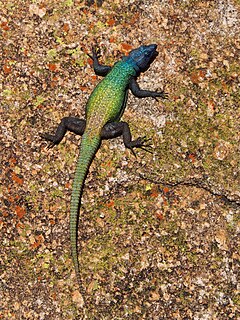
The common flat lizard is a species of lizard in the Cordylidae family. This lizard has 9 subspecies, all living in southern Africa.
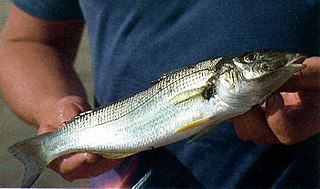
The sand whiting, also known as the summer whiting, yellowfin whiting or blue-nose whiting, is a common species of coastal marine fish of the family Sillaginidae, the smelt-whitings. It is a slender, slightly compressed fish that is very similar to other species of Sillago, with detailed spine, ray and lateral line scale counts needed to distinguish the species between its nearest relative Sillago analis. The sand whiting is distributed along the east coast of Australia from Cape York south to Tasmania, as well as Lord Howe Island and New Caledonia in the Pacific Ocean.
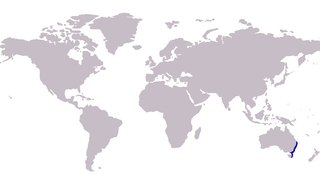
The eastern school whiting, Sillago flindersi, is a species of benthic marine fish of the smelt-whiting family Sillaginidae. The eastern school whiting is endemic to Australia, distributed along the east coast from southern Queensland down to Tasmania and South Australia, where it inhabits sandy substrates from shallow tidal flats to depths of 180 m on the continental shelf. Eastern school whiting prey on various crustaceans and polychaete worms, with the diet varying seasonally and throughout the range of the species. Eastern school whiting reproduce in the deeper waters twice a year, releasing up to 110,000 eggs during a season.
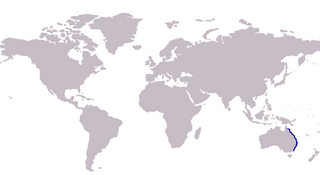
The trumpeter whiting, Sillago maculata, is a common species of coastal marine fish of the smelt-whiting family, Sillaginidae. The trumpeter whiting is endemic to Australia, inhabiting the eastern seaboard from southern New South Wales to northern Queensland. The species is found in bays, estuaries, coastal lakes and mangrove creeks on silty and muddy substrates in waters ranging from 0 to 30 m deep, occasionally inhabiting sandy and seagrass beds.
A number of Actinopterygiian fish have been given the common name whiting.
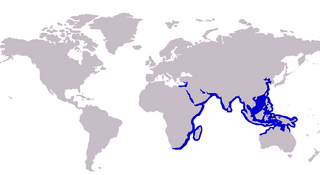
The northern whiting, Sillago sihama, is a marine fish, the most widespread and abundant member of the smelt-whiting family Sillaginidae. The northern whiting was the first species of sillaginid scientifically described and is therefore the type species of both the family Sillaginidae and the genus Sillago. The species is distributed in the Indo-Pacific region from South Africa in the west to Japan and Indonesia in the east, also becoming an invasive species to the Mediterranean through the Suez Canal. The northern whiting inhabits coastal areas to 60 m, but is most often found in shallow water around bays and estuaries, often entering freshwater. It is a carnivore, taking a variety of polychaetes and crustaceans. The species is of major economic importance throughout the Indo-Pacific. It is most frequently taken by seine nets and cast nets and marketed fresh.

The small-scale whiting, is a species of inshore marine fish of the smelt-whiting family Sillaginidae. The small-scale whiting is very similar in body shape and colour to other species in the genus Sillago, but is distinguished by having 12 or 13 spines in the first dorsal fin compared to 11 in all other species. The species is distributed through parts of the west Pacific Ocean including Japan, Taiwan, Korea and India, inhabiting the tidal flats of major estuaries. It is a benthic predator taking crustaceans, molluscs and annelids. Spawning in the species takes place from May to September, with peaks identified in June and July. The eggs and larvae have been extensively studied in order to distinguish them from the more abundant Sillago sihama. Minor fisheries exist for the small-scale whiting, although it is thought be endangered by habitat loss and pollutionIUCN.

The blue whiting, Micromesistius poutassou, one of the two species in the genus Micromesistius in the cod family, is common in the northeast Atlantic Ocean from Morocco to Iceland and Spitsbergen. It also occurs in the northern parts of the Mediterranean, where it may be locally abundant. Blue whiting also occur in the northwest Atlantic Ocean between Canada and Greenland, but is considered rare. It has a long, narrow body and a silvery underbody. The fish can attain a length of more than 40 cm. The average length of blue whiting caught off the west shores of the UK is 31 cm.

Todaropsis eblanae, also known as the lesser flying squid, is a species of short finned squid in the monotypic genus Todaropsis of the family Ommastrephidae.
M. australis may refer to:
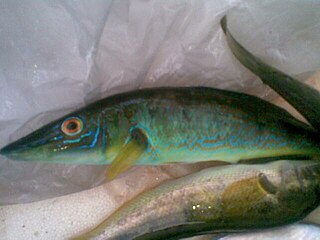
The blue weed whiting is a species of ray-finned fish, a weed whiting from the family Odacidae, which is endemic to Australia where it is only found along the southern coast. It is found in brackish and marine waters in sheltered locations at depths of from 1 to 7 metres. This species inhabits areas with a substrate of sand with beds of seagrass where it feeds on small invertebrates and on algae and the seagrasses themselves. This species grows to a length of 29 centimetres (11 in) SL. It is of minor importance to local commercial fisheries. This species is the only known member of its genus.
Merluccius australis, the Southern hake, is a species of fish from the family Merlucciidae, the true hakes. It is found in the southern Pacific and Atlantic Oceans with two disjunct populations, one around southern South America and the other in the waters around New Zealand.
















